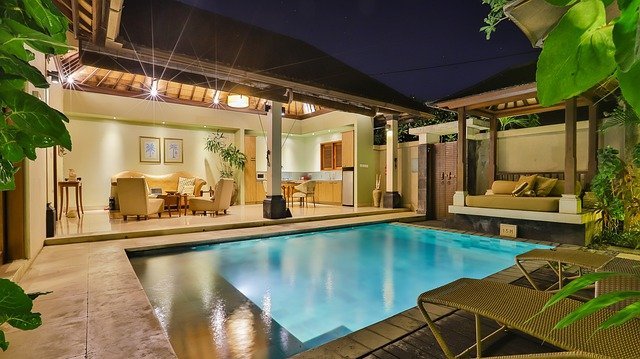Pool Safety Tips for Kids and Pets in the Backyard
When I was searching for a home, I wasn’t seeking for one with a pool. Even though there were just a few properties on the market in my price range, it was interesting to see that two or three of the houses featured in-ground swimming pools.
Finally, I was able to close on one of those properties with a pool. It’s a really large pool! The tank is 22 x 45 feet and holds roughly 40,000 gallons. I had no idea what I was getting myself into when it came to pool ownership when I purchased the home, but I really wanted that place.
They were kind enough to jot down notes regarding the pool and put them on my kitchen counter when I first moved there, which was a wonderful surprise. I also bumped into them when we walked inside the building to sign the documents, and they were quite helpful and offered me a lot of information that day.
As a result, I was left on my own to do more study and learn about pool maintenance and how to keep everyone safe while in and around the pool.
The time it took to do all of this research while moving in and putting the home in order was inconvenient, and it actually stopped me from utilizing the pool until the end of the summer pool season.
Here are some safety recommendations for keeping your children and dogs safe around your backyard pool to save you some time and get you in the water sooner. I hope they will be useful to you.
What Information Do You Need to Be Aware of as a Pool Owner?
As a pool owner, you have certain additional obligations to ensure the safety of yourself and anybody who will be using your swimming pool. Every inhabitant and visitor to the residence must be thoroughly supervised in order to ensure that no mishaps occur.
When the pool isn’t in use, accidents may still happen to swimmers. The risk increases even worse when no one is supposed to be swimming. When no one is watching, it is possible for a kid or pet to stray into the pool and drown.
If a youngster goes missing, the first place to look is the pool. Drowning victims are often unable to cry for aid, so don’t assume they aren’t out there just because you can’t hear them yelling for help. First and foremost, check the pool since every second counts.
Along with maintaining the pool area safe while it is in use and when it is not in use, the pool owner should also be familiar with CPR, have rescue equipment readily available around the pool, and ensure that safe procedures are constantly followed in and around the pool.
First aid supplies, a flotation device, a fully charged mobile phone, and scissors should all be included in your rescue equipment (in case hair or clothing needs to be cut).
Whether or not a pool has a “Swim at your own risk” sign, the pool owner is nonetheless responsible for accidental drownings. Do not depend just on signs and guidelines to guide you. Ensure that no accidents occur by taking all reasonable precautions.
The frequency with which accidents involving backyard pools occur is unknown.
According to the Centers for Disease Control and Prevention (CDC), the average rate of accidental drowning fatalities in the United States is 3,536 per year, or 10 deaths per day. Aside from mortality caused by birth abnormalities, drowning is the top cause of death in children aged 1 to 4, according to the American Academy of Pediatrics. The vast majority of these drownings occur at private residences with swimming pools.
Swimming pool supervision for all members of the family will significantly lower the likelihood of a drowning accident in your backyard pool.
Protecting Children and Pets from Getting into Your Pool Without Being Supervised
Children and dogs should not be allowed to enter the pool unaccompanied in any of the following three ways: It is recommended that you install a pool fence, an alarm, and a safety cover to provide the greatest amount of protection.
Fence Around the Pool
Putting up a fence around your pool with locking gates is the first step in keeping your pool safe. This will keep youngsters and dogs out of the pool when they shouldn’t be in it. It is preferable to have a self-closing and latching gate with a latch that is higher than a small kid can reach in order to prevent accidents.
It is recommended that pool fences be at least 4 feet high. Keep furniture away from the fence so that it does not serve as a stepping stone for people to simply jump over it. You may also want to consider installing vertical bars in your fence to make it more difficult to climb.
Maintain a secure perimeter around the pool while it is not in use, and never leave children or dogs unsupervised in the vicinity of the pool, even for a moment.
The vast majority of pool mishaps occur when “they were just alone for 5 minutes,” according to the statistics.
Despite the fact that I do not have children, I do have a dog that sometimes joins me around the pool. When I need to leave the area for a while, I tell my dog, “let’s go,” and she follows me outside the pool fence, allowing me to lock the gate until I return, which is convenient.
Pool Safety Tips for Kids and Pets in the Backyard
Alarms for the swimming pool.
A pool alarm, like as the Lifebuoy, is another choice for keeping your family safe.
Alarms for swimming pools sound whenever a human or an animal falls into the water. As long as you’re inside, the buoy will connect with an alarm system on the other side of the house through an RF signal. As soon as it senses the splash of a person falling into the water, it will sound a loud alert, allowing you to rush to the scene and save lives. In addition to a pool fence, consider installing a pool alarm for further protection.
Please be assured that while utilizing the pool, you may turn off the alarm, which will automatically switch back on after you have completed your swim. Using your smartphone, you can even control the Lifebuoy’s movement.
Covers for Protection
Pools should be closed throughout the winter months in regions where the winters are very cold. The use of a safety cover can help to keep young children and dogs from accidentally falling into your pool when it’s time to shut it down.
During the swimming season, safety coverings may also be used. When the pool is not in use, you may close the cover to keep your family and others safe from drowning or other injuries.
Safety coverings produce a flat surface at ground level that allows the structure to float on top of the water. Brass anchors and stainless steel springs are used to fasten the covers to the decking surrounding the pool. A variety of safety coverings are available, including solid materials, meshes, and meshes that block the sun.
All three of the safety aspects listed above should be implemented for the utmost in safety.
Learning to Swim with Children
For all children who will be in or near water, it is advised that they take swimming lessons. The American Academy of Pediatrics advises that children begin formal swimming lessons once they become four years of age.. The developmental capacity to learn to remain afloat is reached at this stage in the development of a child’s cognitive abilities.
You may introduce your baby or toddler to water at a younger age (as early as 6 months) by holding them in your arms and allowing them to splash about in the pool or bath.
Toddlers can accomplish a bit more in the water by the time they are two years old. They may begin to float, kick their legs, and blow bubbles in the water if they are given assistance and encouragement..
It is recommended that kids wear a life jacket if you are not hanging on to them. Flotation devices containing air, such as water wings, are far less safe than life jackets. The reason for this is because the air may deflate, leaving the youngster helpless. You will, of course, be present to keep an eye on your youngster and to keep them afloat.
Swimmers are capable of becoming extremely proficient at what they do, but even the best swimmers should always be closely monitored while in the water.
When your older children are able to swim more than an arm’s length away from you, it’s crucial to reiterate the rules about being in the shallow part of the pool and staying away from specific locations, like as the skimmers, that you established earlier.
When you are finished swimming, remove all pool toys from the pool so that they do not serve as a temptation to other kids.
Learning to Swim and Getting Out of the Pool with Your Pet
The saying “all dogs are natural swimmers” will be heard often if you have a dog and a pool. This is incorrect, I’m sorry. When your dog falls into the pool or becomes exhausted because they can’t find their way out, even if they know how to swim, it is important to supervise him or her.
They were blessed to have a buddy who came to their aid, as described below:
The likes of this occur on a regular basis. Taking for granted that dogs are naturally adept swimmers is just not enough.
Certain breeds, such as retrievers and dogs with the word “water” in their name, are better swimmers than others. Even in that case, there are always exceptions to the rule of thumb. It is possible that some dogs outside of these groups may be excellent swimmers, and that some water dogs will be fearful of the water as well.
In most cases, locating a swimming class for dogs will be more difficult than finding one for kids.
It is advisable to put a life jacket on your dog, such as this one, and slowly urge them into the water as much as you can. Provide a shallow location where they may get their feet wet, such as the top step, to help them get acclimated to the water.
Don’t forget to give them plenty of positive reinforcement for being in or near the water and any incremental steps they take toward learning to swim. A significant amount of time may be required. Be patient, take pauses, and repeat the process the next day if necessary..
An additional benefit of canine life vests is that they assist them in learning to swim by supporting them into a good swimming stance so that they may concentrate on paddling forward rather than trying to bear their own weight. Even if you take the vest off, they should eventually get used to the shape that they were in while wearing the garment.
Train them to locate the stairs that go out of the pool after they have mastered swimming. The importance of this is that they will know where to go if they get fatigued.
Teaching your dog where to leave the pool may be accomplished by throwing floating toys into the water and allowing them to retrieve and swim back to you while you are at the pool’s entrance. When they’ve had a little experience getting in and out of the pool, they should be able to find their way out anytime they’re in the mood.
A dog should never be left unsupervised in or around a swimming pool. Always be present to keep an eye on them and to ensure that the pool is properly secured while you aren’t there.
Keep Everyone Safe While Having Fun in the Pool
Before anybody enters the pool, you should have the rescue equipment described above, as well as a posted notice stating the pool laws, a sign demonstrating how to administer CPR, as well as a list of emergency numbers, and flotation devices available.
Remove any tripping hazards from the area surrounding the pool…..
Maintain the “no running around the pool” rule to keep people from tripping over their own feet.
Along with this, you will be responsible for maintaining the pool’s overall safety. The website Trouble Free Pool has an excellent approach on balancing pool chemistry.
In addition to fighting algae and bacteria, maintaining proper pool water chemistry protects your pool and its equipment. You may not be aware of the dangers of swimming in an imbalanced pool of water. It’s an uncommon occurrence, however there is an amoeba that may enter your body via your nose while swimming and consume your brain tissue.
In addition to keeping the water balanced, you’ll want to make sure that your water is circulated sufficiently each day to avoid mosquitoes from hatching on the surface of your pool. In addition, moving the water around helps to prevent algae from growing in the first place.
Final word on pool safety: keep an eye out for youngsters and dogs who may be consuming big quantities of pool water. It seems to be rather straightforward logic, however the rationale behind it may not be as straightforward as it appears.
In most cases, if a tiny quantity of water is consumed, the chlorine levels in home pools are not harmful. If you drink too much pool water, you might get ill from chlorine poisoning. However, this is more likely in public pools than in private pools due to the higher chlorine levels.
Too much water may lead to a condition known as water intoxication. An excellent reason to avoid enrolling in an infant swimming lesson that includes immersing the baby’s head under water is that it might cause brain damage.
Children under the age of two are thought to reflexively hold their breath underwater, yet they will still swallow water.
Water intoxication may also occur in dogs when they are collecting toys from the water or when they are swimming and taking in too much water.
In reality, dogs have died from water intoxication as a result of “biting” at water sprayed from a hose or sprinkler, according to the American Veterinary Medical Association. A detailed explanation of water intoxication in dogs may be found in this article published by Mercola’s Healthy Pets.
Small animals in the pool are prevented from drowning.
It is possible that you will not be aware of this until you have a pool, but tiny animals will drown in your pool at an alarmingly high rate. Swimming in my pool, I’ve come across many dead birds, an injured frog, and even a ground mole!
During that summer, I was fortunate enough to have access to a swimming pool. The sight of my two frog companions splashing about in the water was really rather enjoyable. In my backyard pool, I had two frogs: a large one and a little one that liked to hang around in the water. The large frog was swimming laps with my father while I was at work, and my father would inform me that the giant frog was with him.
I couldn’t believe my eyes when I discovered a dead large frog in the bottom of my skimmer basket at the end of the season!
After seeing him climb out of the shallow end and back in previously, I didn’t believe he required any assistance getting out of the pool this time. My investigation into how to prevent this from occurring again began as soon as I discovered his corpse.
Indeed, it has been shown that frogs have difficulties escaping from water-filled habitats. When I was doing my investigation, I discovered the ideal simple way to aiding the escape of frogs and other tiny creatures from a swimming pool. “Frog Log” is what it’s called.
In my experience, birds were unable to make their way inside the Frog Log, and I did not discover any other dead animals in my pool throughout the whole summer that I had two Frog Logs in my pool. When I didn’t have the Frog Logs out, the ground mole that I had mentioned perished, and I’ve learned my lesson.
I’ll put them in the pool on the day I open it each year now.
In addition to being a sad and nasty sight to discover dead animals in your pool, it also introduces germs into your water that you do not want there. You will want to shock your pool after removing the dead animal from it, and then wait for the chlorine levels to restore to safe swimming levels before allowing anybody back into the pool.
Lastly, a word about
When it comes to pool ownership, as you can see, there is an enormous amount of duty. Follow the guidelines outlined above and always use safe pool-keeping techniques to keep children and pets safe in your swimming pool environment.
As soon as you’ve learned how to keep everyone safe, go have some fun in your backyard paradise.





